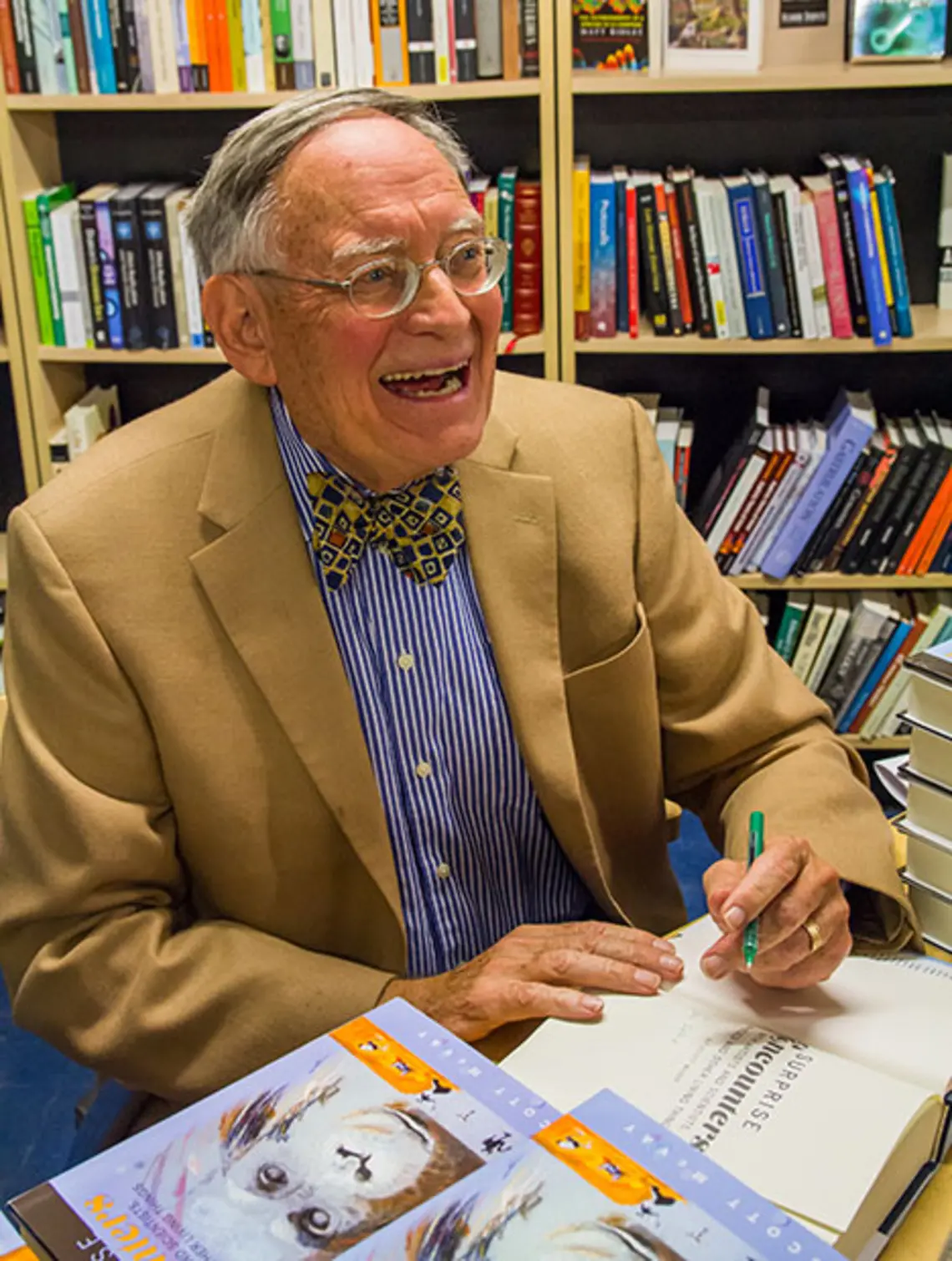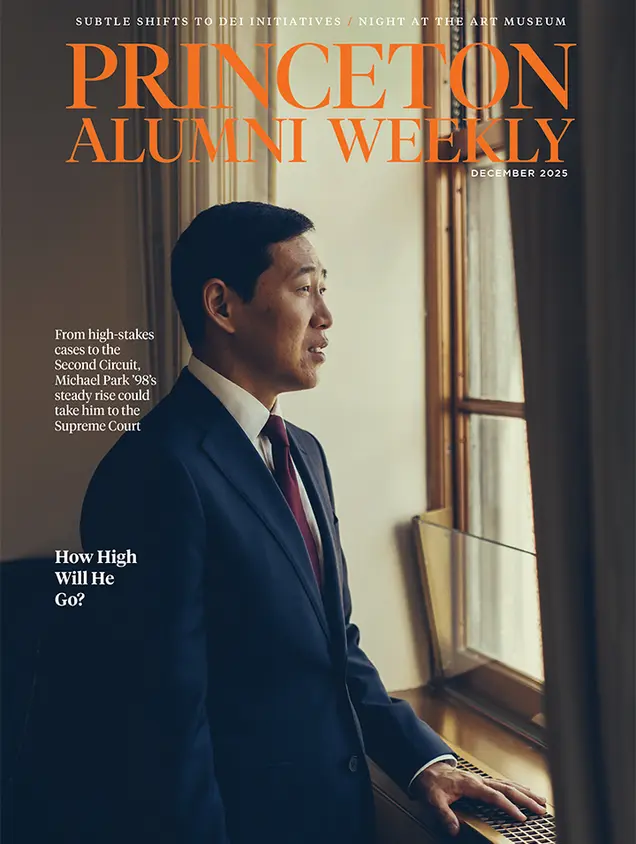
Scott McVay ’55 has written a memoir, Surprise Encounters, featuring vignettes drawn from decades working at universities and foundations and in the sciences. In a recent oral-history interview, he shared stories about his many ties to Princeton, and in the excerpts here, he speaks about a pair of notable Princetonians: former president Robert Goheen ’40 *48 and former provost Neil Rudenstine ’56.
PAW podcasts are also available on iTunes — click here to subscribe
TRANSCRIPT
Brett Tomlinson: If “luck is the residue of design,” as the baseball executive Branch Rickey famously said, then it should come as no surprise that good fortune has shined on Scott McVay ’55. Take, for example this story about his encounter with the marine biologist John C. Lilly, who visited Princeton in December 1961, when McVay was working as the University’s recording secretary.
Scott McVay: John Lilly had written one book at that point; he eventually wrote 10 or 12, 14. But he published one book called Man and Dolphin, in which he put forth the idea that here's a creature in a weightless environment that has a brain a little larger than ours and with more interconnections, and very quick. And so he put forth the idea that they may have a level of cognition and awareness akin to us, however alien.
Well he gave this talk. And after everybody left I came up and I said Dr. Lilly, I said, “Where are you going now?” He said New York. I said, “How are you getting there?” He said by train. I said, “Do you mind if I ride in with you? I have a few questions.” OK.
So I had actually typed out 82 or 83 questions from the book — I had read it very closely. And we got through 51 or 52 of these questions, and then he hounded me to come to work for him. And I said, “Look, there are a lot of young marine biologists that are pounding on your door for the chance to work with you.” I said, “I'm just an English major who read Moby Dick.” … I’ve got two little girls and I’ve got a secure position and who knew what was going to happen in this damn dolphin laboratory? But he hounded me to come down there, over the next two years, and then I eventually went down there and went to work for him for two years.
BT: That’s two years in a long and varied career. McVay maintained a deep interest in dolphins and whales, but he’s also worked in university administration, headed two charitable foundations, served as president of the Chautauqua Institution, and forged friendships with scores of notable artists, scientists, academic leaders, and political figures. His 2015 memoir, Surprise Encounters with Artists and Scientists, Whales and Other Living Things, features a lifetime of colorful vignettes — 152, to be precise.
In this episode of PAW Tracks, we highlight McVay’s recollections of two Princetonians: former president Robert Goheen ’40 *48, and former provost Neil Rudenstine ’56. We’ll begin with Goheen, who recruited McVay for a job at Nassau Hall, during McVay’s stint studying dolphins.
SM: I came back for my 10th reunion and President Goheen, this is now 1965, asked if I would be his special assistant in One Nassau Hall, and that’s of course when he was working to bring about coeducation with an old board, who were smiling, friendly, but kind of stuck maybe in thinking what was good enough for me is good enough for anybody else. But Goheen picked up on the fact that there were certain remarkable students who were turning Princeton down to go to a coeducational institution. And so he brought that about. The vote was 16 to 9 on the board — it was a squeaker.
He was the most focused and disciplined individual I’ve ever met. And what you’ve got to imagine is that if any student or alumnus got the itch to think they had to talk to the lead guy, they’d pick up the phone and say I’ll be in town tomorrow at 3 o’clock. I mean, even then you can’t imagine — you’ve got an alumni body of tens of thousands and then a student population of 5, 6, 7,000, and then the other thing is they when they’d meet with him the students never thought that maybe he has this job because he’s immensely competent and he’s good at it.
They’d start as peers, you know, in the course of the meeting the students would begin to think, oh my God, I’m dealing with somebody who thinks on their feet and has anticipated several steps beyond what I’m pitching at the moment. So it was that kind of thing.
He had his own fearsome agenda, all the board meetings, all of that. And another thing, for example, if he accepted a speaking invitation, say, or to go to some event on a given date and time, and something else came along, I would’ve thought, well, he’s going to scrap that other one because this is 10 times as interesting. No, he held with the prior commitment, I mean, unswervingly — that kind of integrity is so rare.
BT: In this excerpt from McVay’s book, he briefly recalls a moment of levity from his time in Nassau Hall.
SM: One day, perhaps in 1966, I had prepared a few suggested remarks for opening three events on campus, one after another. When [Goheen] returned to the office, head down, focused on the next thing, I asked him, “How’d it go?” He left lifted his head, while moving along, and said, “Little holy water here little holy water there.”
BT: In another story, McVay remembers when he was tasked with preparing a list of candidates for the job of dean of students, after William Lippincott announced his intention to step down.
SM: I prepared a list of 10 or a dozen prospects, and Goheen put a crisp arrow beside the name of Neil Rudenstine and asked me to invite him down from Harvard for a visit. When I reached Neil to convey the invitation, he replied, “Under no circumstances.” He was happy with his teaching and scholarship as an assistant professor of English and a tutor at Adams House.
I asked if he would be willing to do the president the courtesy of travelling briefly to Princeton to meet with him. Neil said that he was not interested in administration and politely declined. I pushed the courtesy angle. (Neil was a year behind me, and he was a Rhodes Scholar, his father was a security guard.) I pushed the courtesy angle, and Neil finally relented. A date was set, he traveled to Princeton, and after meeting with Goheen signed up for a five-year stint as dean of students.
I mean, he goes in with one idea, and Goheen talks to him and he totally, totally changed what he had actually set as his life course. He served in that job from 1968 to 1972. Then he became the dean of the college from 1972 until 1977 under President William Bowen [*58], and then became provost from 1977 to 1988.
Bowen and Rudenstine went on to the Andrew W. Mellon Foundation — that was one of the big 25, with assets of more than a billion, and they were distinguished by from other foundations in that they make big grants — Bowen was president and Neil was executive vice president at the Andrew W. Mellon Foundation.
Then Neil took on the presidency of Harvard for 10 years from 1991 to 2001, chosen in part because of his administrative experience. And so the day follows the night.
BT: Goheen and Bowen, and Rudenstine himself of course, deserve the credit for his development from a professor to a college president. But McVay is happy to have played some small role in the beginning.
SM: I’m thinking, if I had accepted his unwillingness to come down here, he never would become president of Harvard.
BT: The story also has bearing on today’s Princeton, McVay says: When Christopher Eisgruber ’83 was mulling over an opportunity to be the University provost in 2004, he asked Rudenstine for advice. Eisgruber, of course, took the job, and in 2013 became Princeton’s president.
Our thanks to Scott McVay for sharing these stories and many others. The full transcript and recording from this PAW Tracks interview will be added to the University Archives.
If you have a story to share, we’d love to hear it. Email us at paw@princeton.edu.
Brett Tomlinson produced this episode. The music is from FirstCom Music.
Paw in print

December 2025
Judge Michael Park ’98; shifts in DEI initiatives; a night at the new art museum.

1 Response
Frauken Grohs Collinson w'22
7 Years AgoMeeting Scott McVay
In late September 2016, I had the privilege to visit the Princeton University Art Museum and the special “For-Members-Only” reception and lecture. The evening began with Dr. James Steward presenting a superb lecture about the exhibition, “A Material Legacy,” bringing forth a deeper understanding of its far-reaching contemporary art. And afterward at the food table was Scott McVay discussing his enjoyment of figs with my daughter Rose Mary, who soon introduced him and his wife Hella to me. It indeed was a wonderful surprise to meet the McVays. It just so happened that Scott McVay’s father was a classmate and friend of my late husband, Harry Noyes Collinson, Class of 1922. And his wife Hella is from Berlin and like a blitz, we spoke German and English intermingled together. We talked about the art of my father, Hans Friedrich Grohs (1892-1981). I had become the sole inheritor of the Grohs estate and shipped the art to the USA and established the Frauken Grohs Collinson-Grohs Collection Trust, Archive and Library.
Our trip included a gift in kind of the Hans Friedrich Grohs art to the wonderful and special Art Museum of Princeton University. Also another gift to fulfill our promise will soon be made. More of his art can be seen on our Hans Friedrich Grohs (1892-1981) Facebook page or by searching Google images.
My past visits to Princeton University are everlasting memories to me.